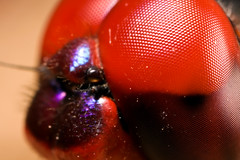I’ve contended for years that diffraction, although a real photographic effect and defect, is not the big boogeyman that some people make it out to be –that getting a sharp image circle and controlling motion during the exposure are infinitely more important. It’s also my humble opinion that a lot of what people are calling diffraction is nothing more than “macro motion blur” –slight movement, maybe as little as the width of half a pixel, that robs the image of detail…
I base my opinion on experience –from the time that I started concerning myself with flash duration and making it as short as possible the detail in my images has gone up, like the shot included with this post that was taken at 5x and F11. I’m frequently asked if I focus stack my images due to the level of detail in them and the depth. I played with stacking almost two years ago and didn’t like the effect it had on the background and the overall composition of an image –all of the photos you see in my galleries are single frame. The depth and the sharpness come from carefully controlling where I place the area of acceptable focus and from a short flash duration.
So I know that it’s a myth that the flash duration, no matter how long, can always freeze motion. At the risk of sounding like I have my nose in the air: The proof is in my images…
I can understand why some people would get confused: You’re shooting at 3x, F11, and ISO 100 (the shutter speed isn’t really important since at those settings you’re not going to get any ambient light into the lens anyway). You take a shot and it’s just not as sharp as you’d want it to be, so you drop down to F8 and you’re image has more detail. So diffraction lost, right? Well, there’s just one little problem: When you changed from F11 to F8 the amount of light your flash had to produce to give you a proper exposure dropped in half, so your flash duration for the F8 shot was half as long (or twice as fast) as the flash duration for the shot you took at F11. So did diffraction rob you at F11, or did a “faster virtual shutter speed” defeat motion blur at F8? Hmmm…
Getting your flash closer to the subject, and using a diffuser that diffuses the light instead of just blocking it, will give you shorter flash durations and you just might get the level of detail you’re looking for when shooting at high magnifications and Fstops –but you’ll never try it as long as you believe the diffraction myth…
There’s an interesting thread over at DP Review and another at the Fred Miranda Macro Forum about this very subject. If you want to jump in then do yourself a favor and read the posts carefully –one person already tried to have a go at me by taking something out of context. One of the problems with the current debate on diffraction is that too many people have based their photographic style on the belief that diffraction is a big problem –and some of them don’t want to hear that they might be wrong…
Before I end this post let me make one thing perfectly clear: I don’t care how you take your photos, because how you get from a concept to a shot is irrelevant –the only thing that counts is the final image because that’s the only thing the viewer sees. No matter how this story ends it’s not going to change the way that I take photos since I’ve developed a photographic style that doesn’t require focus stacking –light and composition are infinitely more important than depth of field…


5 comments:
> ...the flash speed isn’t really important since at those settings you’re not going to get an ambient light into the lens anyway)
I think you meant "the shutter speed..."
Great article.
Fixed -thanks!
Since the MT-24EX provides a "virtual shutter speed" between 1/1000 and 1/3000 (which I understood, might not be enough to freeze motion), why can't we use highsync and at shutter speeds superior to 1/3000?
Excellent question Adrian. The problem with high speed sync is that it works by pulsing the flash as the shutter is passing in front of the sensor. Each pulse captures a "slice" of the final exposure, like laying transparencies down on a projector. So any movement (the camera or the subject) is going to get recorded and you'll lose detail. At high shutter speeds the shutter doesn't really open all the way -one curtain will start to open while the second one very quickly begins to close, so that just a thin slit is moving across the sensor. So as the flash pulses you're just getting one very small area of the scene exposed at a time and movement is still a problem. I've tried high speed sync myself and it doesn't work. There just doesn't seem to be a substitute for a single, synchronized pulse from the flash. The trick is to get that pulse as short as possible...
This has sense. I knew the flash is pulsing in highsync but didn't know that what we get is actually "slices".
What I don't understand is how can we get the shortest flash duration. Doesn't the flash always has the same speed and if not, how can we control it?
If I remember well you said that having the flash heads as close as possible to the subject, gives as a "faster" flash. Correct?
Thank you very much for the answers!
Post a Comment